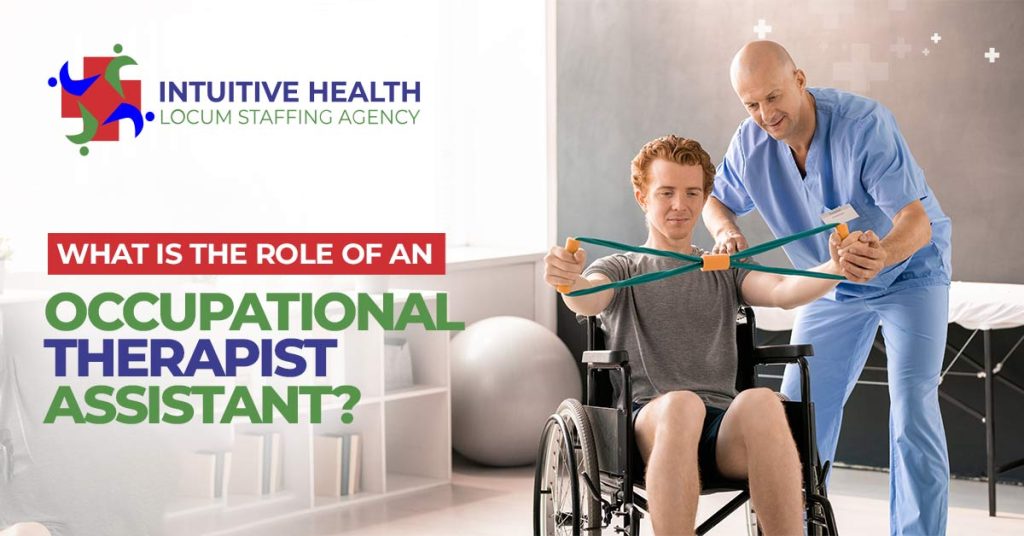Did you know there are professionals who help children learn how to hold and write with a pencil? These skilled specialists are called Occupational Therapist Assistants (OTAs), and their work goes far beyond just teaching handwriting. OTAs play a vital role in helping people of all ages regain the skills they need to live independent, fulfilling lives. They’re the professionals who help a child improve fine motor skills, assist someone recovering from an injury, and support older adults in maintaining daily routines.

In this blog, we’ll explore what OTAs do, where they work, and which steps you can follow to get into the field if you aspire to become an OTA.
What Is an Occupational Therapist Assistant?
An Occupational Therapist Assistant, also known as Rehabilitation Aide, or OTA, works under the supervision of a licensed Occupational Therapist (OT) to support patients in their recovery. Their main job is to help people improve the skills needed to perform everyday tasks, including getting dressed, eating, or going back to work after an injury. These tasks may sound simple to you, but for someone recovering from surgery, a stroke, or living with a disability, they can be challenging.
OTAs help bridge the gap between a patient’s current ability and their personal goals. They use structured, therapeutic activities to help individuals reach a higher level of function. These healthcare professionals allow people to improve their quality of life, especially for patients who want to regain independence.
What Does an OTA Do?
The daily work of an OTA varies depending on the healthcare setting they work in, but their work always revolves around improving patients’ lives. Here’s what their daily tasks look like:
- Guides patients through therapeutic activities that support recovery and independence
- Sets up and prepares equipment and materials needed for each session
- Encourages patients to stay motivated during challenging exercises
- Tracks patient performance and shares updates with the supervising occupational therapist
- Demonstrates safe ways to perform everyday tasks, like dressing or meal prep
- Offers tips and adaptive strategies for using tools and devices at home
- Helps patients build routines that support physical, mental, and emotional goals
- Works directly with caregivers to ensure they understand the home care plan
- Monitors for any physical or emotional changes and reports them promptly
- Adjusts session tasks to match each patient’s current ability and progress
Work Environments Where OTAs Practice
Occupational Therapist Assistants work in various settings across the country. Depending on the patient’s needs and the type of care, OTAs may be found in:
- Schools
- Hospitals
- Outpatient clinics
- Mental health centers
- Rehabilitation centers
- Pediatric care centers
- Assisted living facilities
- Skilled nursing facilities
- Home healthcare settings
- Community health programs
Looking for a flexible job as an OTA? Explore high paying Occupational Therapist Assistant roles in the USA.
How to Become an Occupational Therapist Assistant?
To become an OTA in the U.S., you need formal training and certification. Here’s a step-by-step guide to follow if you aspire to become a Rehabilitation Assistant:
- Earn an Accredited Associate Degree
To start, you need to complete an Associate Degree in Occupational Therapist Assistant from a program that is accredited by the Accreditation Council for Occupational Therapy Education (ACOTE). These programs typically take about two years and are offered at technical schools and community colleges across the United States.
The coursework combines classroom learning with practical fieldwork. You’ll study subjects like:
- Professional ethics
- Therapeutic techniques
- Patient care procedures
- Anatomy and physiology
- Psychology and human development
Hands-on clinical experiences give you real-world exposure to different patient populations and treatment approaches.
- Pass the NBCOT Certification Exam
After completing your degree, you must pass the National Board for Certification in Occupational Therapy (NBCOT) exam to become a registered OTA. This exam assesses your knowledge and readiness to practice safely and effectively. It demonstrates your professional competency. It also makes you eligible for state licensure in most states.
- Obtain State Licensure
Each state in the U.S. requires OTAs to hold a license or certification to practice legally. Licensing rules vary, but most states require:
- Graduation from an ACOTE-accredited OTA program
- Completion of a background check
- Successful NBCOT certification
- Payment of licensing fees
Check your specific state’s occupational therapy board website for exact details.
- Continuing Learning and Education
To keep your NBCOT certification and state license active, you must complete continuing education units (CEUs) regularly. These courses make you stay current with new therapy techniques, healthcare laws, and patient care standards.
Continuing education topics might include:
- Patient safety protocols
- Ethical practices in healthcare
- Advances in occupational therapy
- Specialized care approaches (e.g., pediatrics, geriatrics)
- Optional: Pursue Advanced Specializations
While not required to practice, some occupational therapist assistants choose to earn specialty certifications or training in areas like:
- Hand therapy
- Assistive technology
- Pediatric occupational therapy
These credentials can improve job prospects and allow OTAs to work with specific patient groups or in specialized settings.
This career path offers a great balance of education and job opportunities. It’s perfect for those who want to work in healthcare but don’t want to spend years in school.
Suggested Read: Work-Life Balance in Health Department Jobs: Is It Possible?
Occupational Therapy Aides Skills and Qualities
Being an occupational therapist assistant requires more than just technical knowledge. To be successful in this field, you need strong soft skills and a caring attitude. Here are the top qualities every OTA should have:
- Clear communication
- Active listening
- Empathy and compassion
- Patience and encouragement
- Physical stamina
- Creative problem-solving
- Attention to detail
- Teamwork and collaboration
- Dependability and reliability
OTAs also need to stay organized and be able to adapt quickly when a patient’s needs change. These qualities help build trust and make the therapy more effective.
Suggested Read: The Essential Skills Needed for Health Department Jobs
What Do Occupational Therapist Assistants Treat?
OTAs help treat a wide range of conditions that affect a person’s ability to function in daily life.
Here are some common challenges they address:
- Neurological conditions: Stroke, multiple sclerosis, traumatic brain injuries
- Orthopedic issues: Broken bones, joint replacements, arthritis
- Developmental delays: Autism spectrum disorder, Down syndrome, learning disabilities
According to a study, occupational therapy, led by OT and OTA, helped improve cognitive and psycho-social abilities for 63% of patients.
- Mental health challenges: Depression, anxiety, PTSD, especially when these interfere with daily living
- Chronic illnesses: Parkinson’s disease, diabetes-related complications
When to See an Occupational Therapist Assistant?
A person should consider seeing an OTA if they struggle to do basic tasks due to an injury, illness, or disability. Signs that someone might benefit from an OTA’s help include:
After Surgery or Injury:
- Rebuild strength and independence
- Recover from fractures or joint replacements
After a Stroke or Neurological Event:
- Relearn daily skills like dressing and eating
- Improve coordination and mobility
For Children with Developmental Challenges:
- Support developmental delays
- Enhance fine motor skills and participation in school
Managing Chronic Health Conditions:
- Address difficulties from arthritis, Parkinson’s, or multiple sclerosis
- Maintain or improve daily functioning
When Daily Tasks Become Difficult:
- Struggle with dressing, cooking, or bathing
- Face physical or cognitive barriers to independence
Early Intervention and Rehabilitation:
- Promote faster recovery and prevent complications
- Support return to home, school, or work activities
Salary Expectations and Job Outlook for Occupational Therapist Assistants
The demand for OTAs continues to grow in the United States. U.S. Bureau of Labor Statistics anticipates the job market for OTAs to grow 21% from 2023 to 2033, which is much faster than the national average for all occupations.
Your compensation depends on where you work, your level of experience, and your specialty. Occupational therapy aides in big cities or in-home healthcare often earn more than those in smaller clinics.
Suggested Read: Top 10 High-Demand Health Department Jobs In the USA
Find the Right OTA Jobs with Intuitive Health Services
Occupational Therapist Assistants play an important role in helping people regain independence and live fuller lives. Every day, they make a difference by supporting patients through challenges that might seem simple to us but are a big deal to people struggling with them.
If you’re a certified OTA searching for your next role, opt for an accredited healthcare staffing agency to find a role best suited to your needs and goals. At Intuitive Health Services, we work closely with healthcare professionals to find opportunities that match your skills, lifestyle, and ambitions. Whether you want flexible hours, better pay, or a work environment where you feel valued, we’re here to help.
Connect with us today.

